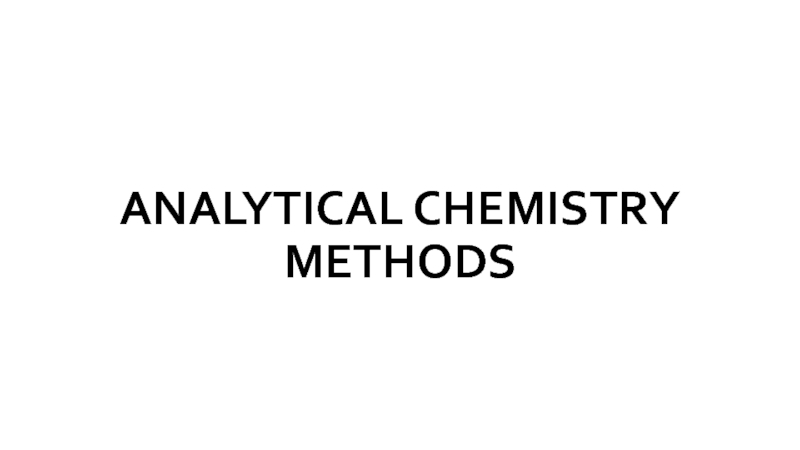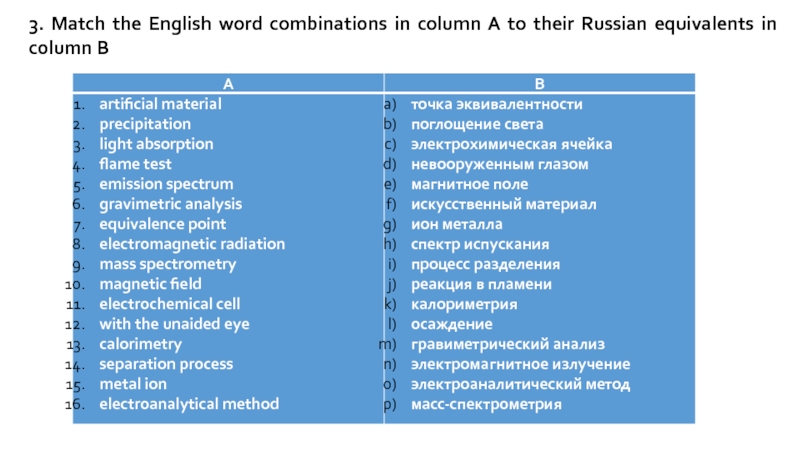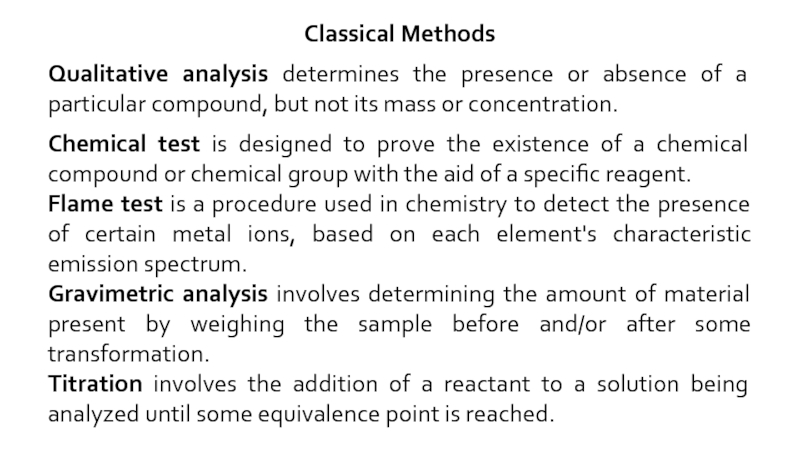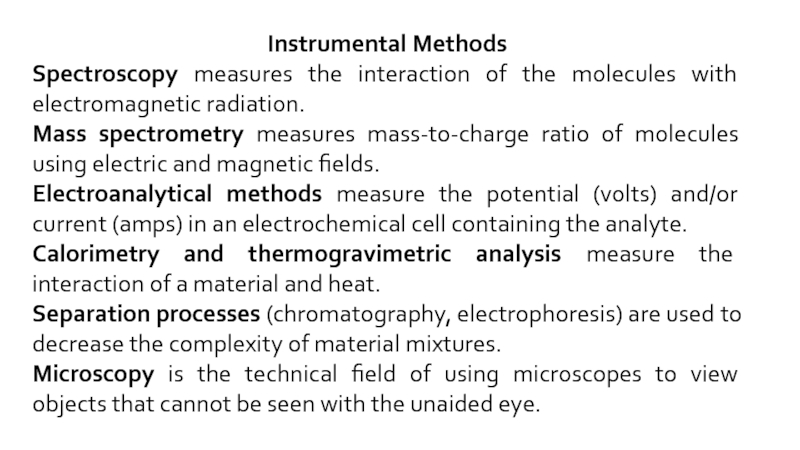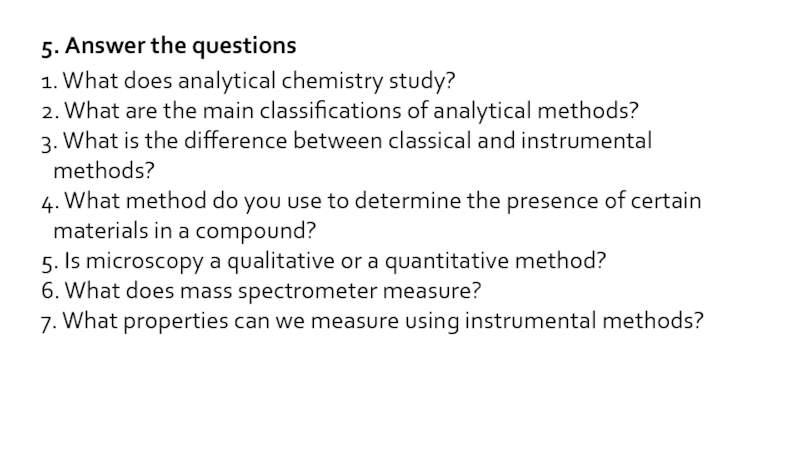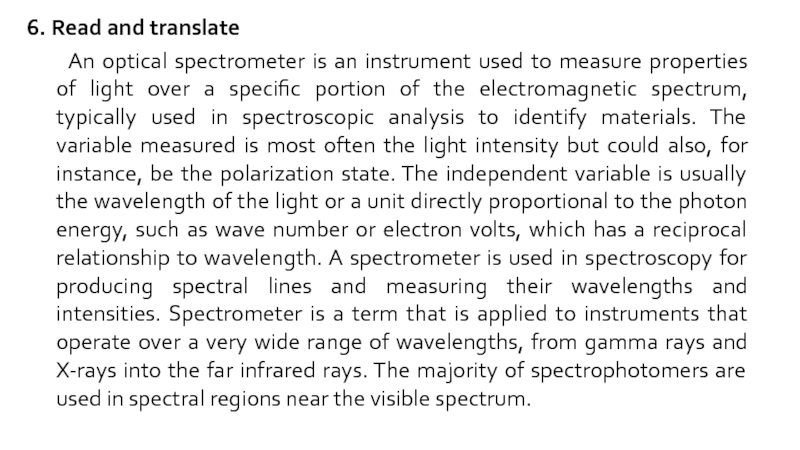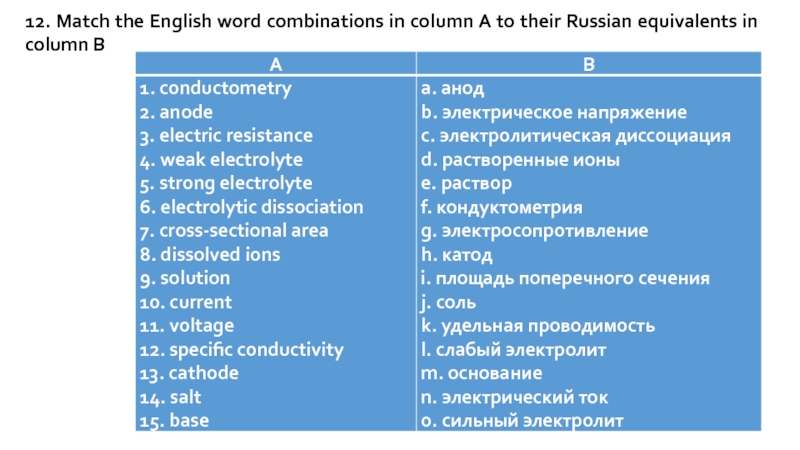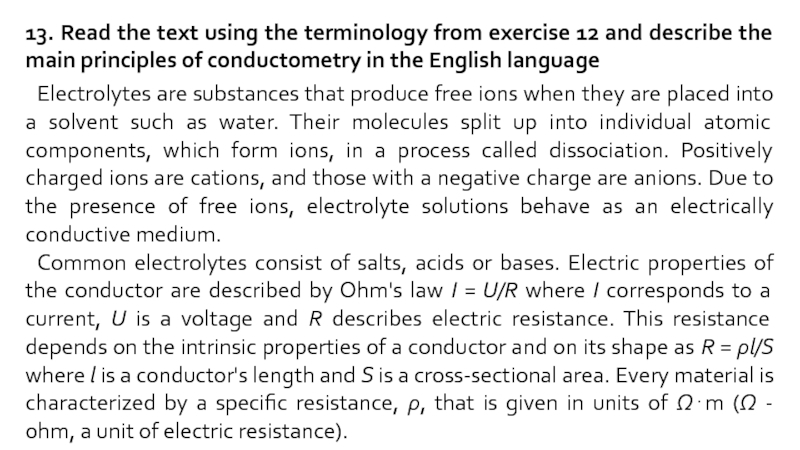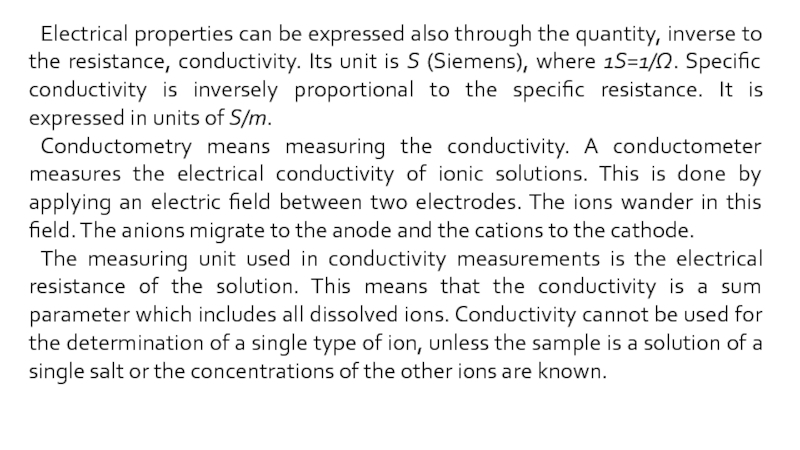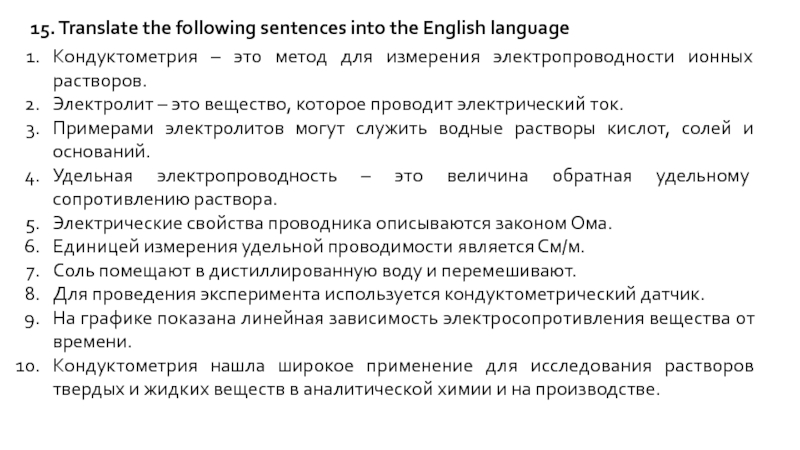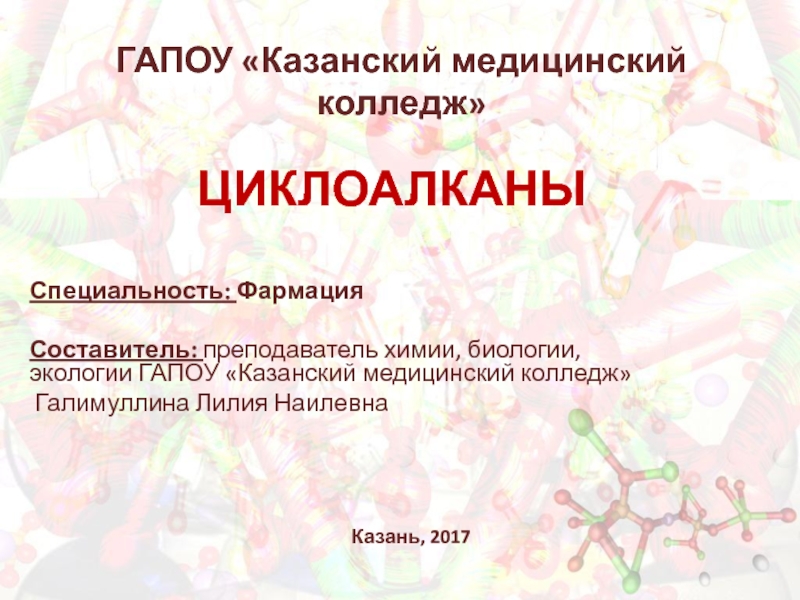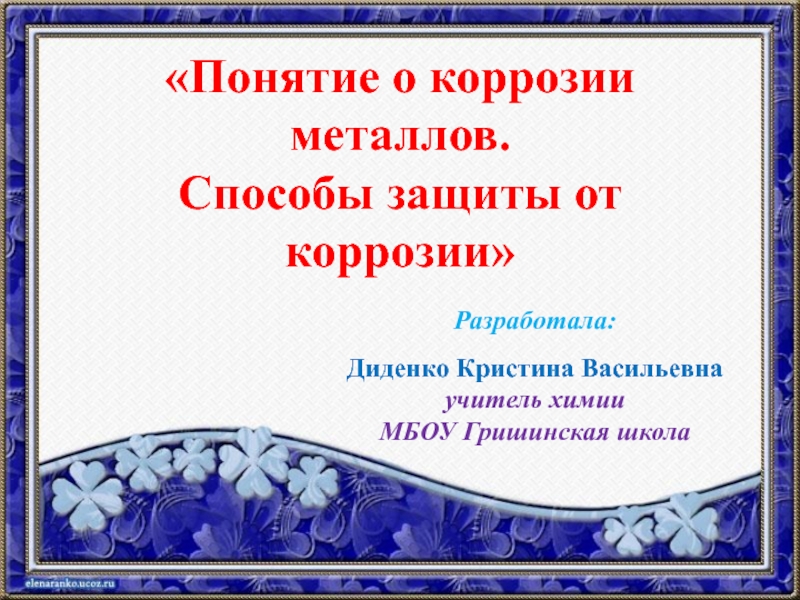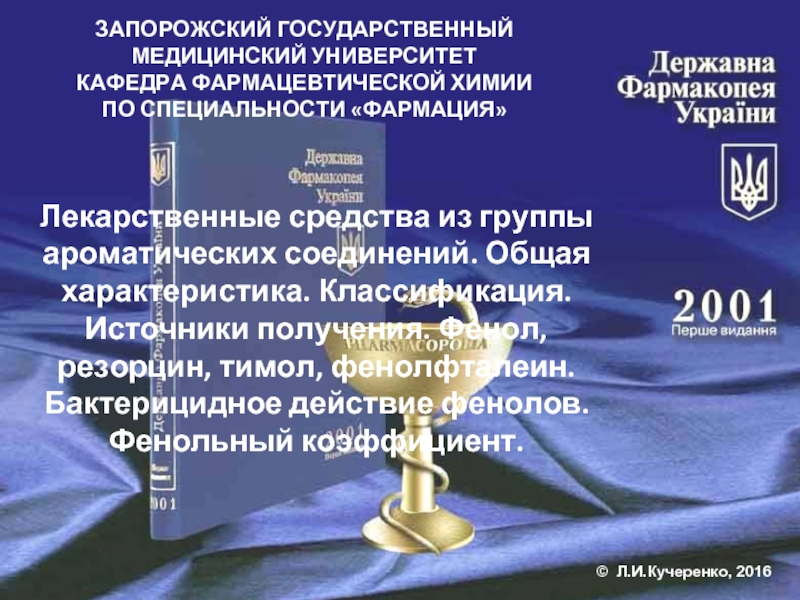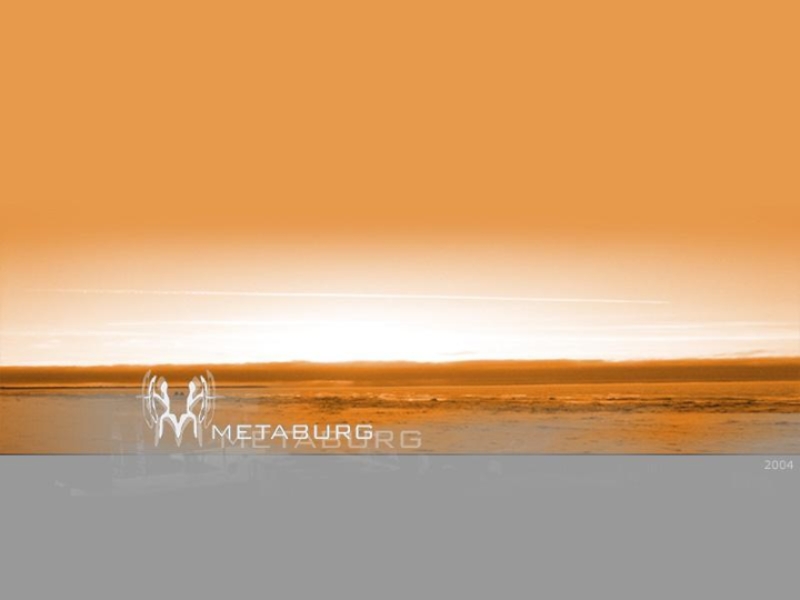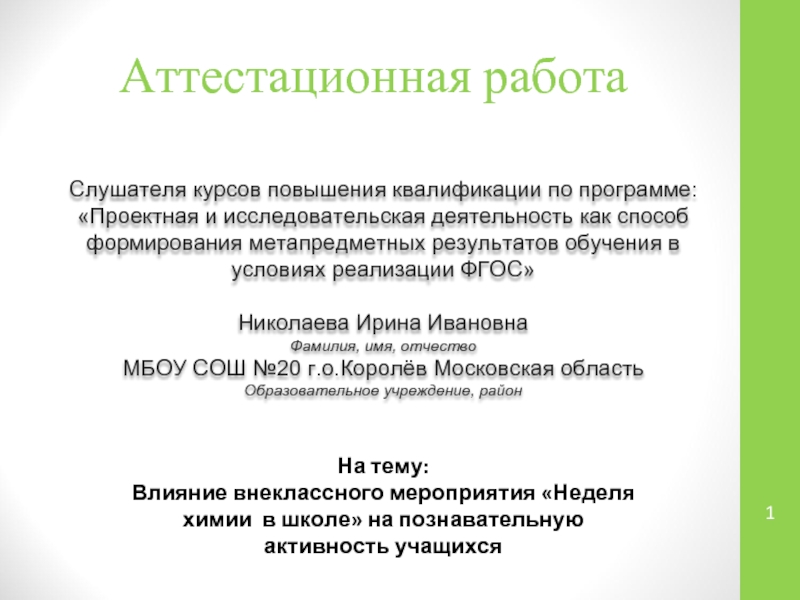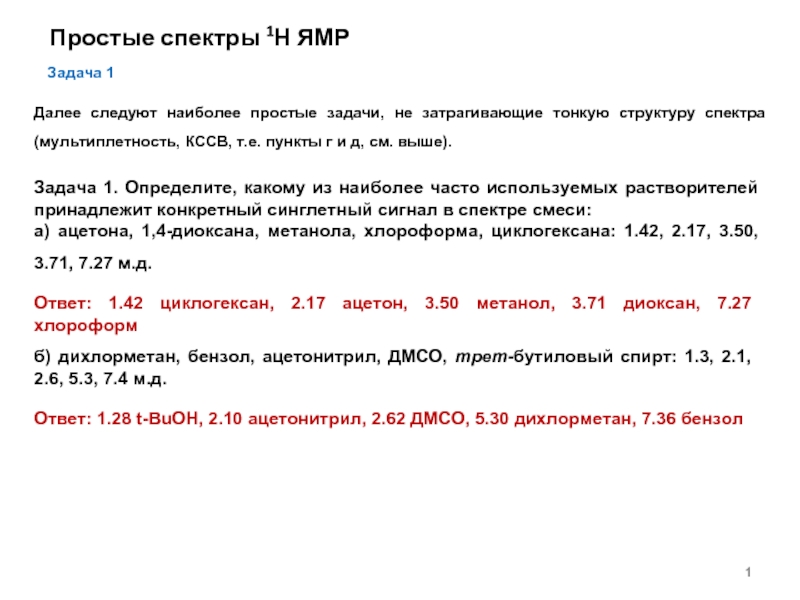- Главная
- Разное
- Дизайн
- Бизнес и предпринимательство
- Аналитика
- Образование
- Развлечения
- Красота и здоровье
- Финансы
- Государство
- Путешествия
- Спорт
- Недвижимость
- Армия
- Графика
- Культурология
- Еда и кулинария
- Лингвистика
- Английский язык
- Астрономия
- Алгебра
- Биология
- География
- Детские презентации
- Информатика
- История
- Литература
- Маркетинг
- Математика
- Медицина
- Менеджмент
- Музыка
- МХК
- Немецкий язык
- ОБЖ
- Обществознание
- Окружающий мир
- Педагогика
- Русский язык
- Технология
- Физика
- Философия
- Химия
- Шаблоны, картинки для презентаций
- Экология
- Экономика
- Юриспруденция
Analytical chemistry methods презентация
Содержание
- 1. Analytical chemistry methods
- 2. 1. Read and translate the international words
- 3. 3. Match the English word combinations in
- 4. 4. Read and translate Analytical Chemistry Analytical
- 5. Classical Methods Qualitative analysis determines the presence
- 6. Instrumental Methods Spectroscopy measures the interaction of
- 7. 5. Answer the questions 1. What does
- 8. 6. Read and translate An optical spectrometer
- 9. 7. Read and translate the text into
- 10. 8. Find the Russian equivalents for the
- 11. 10. Look at the diagram of a
- 12. 11. Complete the description of nuclear magnetic
- 13. 12. Match the English word combinations in
- 14. 13. Read the text using the terminology
- 15. Electrical properties can be expressed also through
- 17. Briefly describe the experimental process. Describe the
- 18. 15. Translate the following sentences into the
Слайд 21. Read and translate the international words
Analysis, analytical, separation, identification, component,
indication, classical, instrumental, extraction, distillation, apparatus, absorption, chromatography, electrophoresis, clinical, procedure, reagent, thermogravimetric, calorimetry, emission, fluorescence, titration, microscope.
2. Read and translate the verbs
To analyze, to separate, to identify, to determine, to achieve, to base, to detect, to weight, to add, to measure, to view, to focus on, to accomplish, to provide, to probe.
2. Read and translate the verbs
To analyze, to separate, to identify, to determine, to achieve, to base, to detect, to weight, to add, to measure, to view, to focus on, to accomplish, to provide, to probe.
Слайд 44. Read and translate
Analytical Chemistry
Analytical chemistry is the study of the
separation, identification, and quantification of the chemical components of natural and artificial materials. Qualitative analysis gives an indication of the identity of the chemical species in the sample, while quantitative analysis determines the amount of one or more of these components. Analytical methods can be classified as classical and instrumental ones. Classical methods use separations such as precipitation, extraction, and distillation and qualitative analysis by color, odor, or melting point. Quantitative analysis is achieved by measurement of weight or volume. Instrumental methods use an apparatus to measure physical quantities of the analyte such as light absorption, fluorescence, or conductivity.
Слайд 5Classical Methods
Qualitative analysis determines the presence or absence of a particular
compound, but not its mass or concentration.
Chemical test is designed to prove the existence of a chemical compound or chemical group with the aid of a specific reagent.
Flame test is a procedure used in chemistry to detect the presence of certain metal ions, based on each element's characteristic emission spectrum.
Gravimetric analysis involves determining the amount of material present by weighing the sample before and/or after some transformation.
Titration involves the addition of a reactant to a solution being analyzed until some equivalence point is reached.
Chemical test is designed to prove the existence of a chemical compound or chemical group with the aid of a specific reagent.
Flame test is a procedure used in chemistry to detect the presence of certain metal ions, based on each element's characteristic emission spectrum.
Gravimetric analysis involves determining the amount of material present by weighing the sample before and/or after some transformation.
Titration involves the addition of a reactant to a solution being analyzed until some equivalence point is reached.
Слайд 6Instrumental Methods
Spectroscopy measures the interaction of the molecules with electromagnetic radiation.
Mass spectrometry measures mass-to-charge ratio of molecules using electric and magnetic fields.
Electroanalytical methods measure the potential (volts) and/or current (amps) in an electrochemical cell containing the analyte.
Calorimetry and thermogravimetric analysis measure the interaction of a material and heat.
Separation processes (chromatography, electrophoresis) are used to decrease the complexity of material mixtures.
Microscopy is the technical field of using microscopes to view objects that cannot be seen with the unaided eye.
Слайд 75. Answer the questions
1. What does analytical chemistry study?
2. What are
the main classifications of analytical methods?
3. What is the difference between classical and instrumental methods?
4. What method do you use to determine the presence of certain materials in a compound?
5. Is microscopy a qualitative or a quantitative method?
6. What does mass spectrometer measure?
7. What properties can we measure using instrumental methods?
3. What is the difference between classical and instrumental methods?
4. What method do you use to determine the presence of certain materials in a compound?
5. Is microscopy a qualitative or a quantitative method?
6. What does mass spectrometer measure?
7. What properties can we measure using instrumental methods?
Слайд 86. Read and translate
An optical spectrometer is an instrument used to
measure properties of light over a specific portion of the electromagnetic spectrum, typically used in spectroscopic analysis to identify materials. The variable measured is most often the light intensity but could also, for instance, be the polarization state. The independent variable is usually the wavelength of the light or a unit directly proportional to the photon energy, such as wave number or electron volts, which has a reciprocal relationship to wavelength. A spectrometer is used in spectroscopy for producing spectral lines and measuring their wavelengths and intensities. Spectrometer is a term that is applied to instruments that operate over a very wide range of wavelengths, from gamma rays and X-rays into the far infrared rays. The majority of spectrophotomers are used in spectral regions near the visible spectrum.
Слайд 97. Read and translate the text into the English language using
the diagrams of atomic force microscope
Атомно-силовой микроскоп (АСМ) – это сканирующий зондовый микроскоп высокого разрешения. Принцип работы АСМ основан на регистрации силового взаимодействия между поверхностью исследуемого образца и зондом. В качестве зонда используется наноразмерное остриё, располагающееся на конце упругой консоли, называемой кантилевером. Сила, действующая на зонд со стороны поверхности, приводит к изгибу консоли. Появление возвышенностей или впадин под остриём приводит к изменению силы, действующей на зонд, а, значит, и изменению величины изгиба кантилевера. Таким образом, регистрируя величину изгиба, можно сделать вывод о рельефе поверхности.
Атомно-силовой микроскоп (АСМ) – это сканирующий зондовый микроскоп высокого разрешения. Принцип работы АСМ основан на регистрации силового взаимодействия между поверхностью исследуемого образца и зондом. В качестве зонда используется наноразмерное остриё, располагающееся на конце упругой консоли, называемой кантилевером. Сила, действующая на зонд со стороны поверхности, приводит к изгибу консоли. Появление возвышенностей или впадин под остриём приводит к изменению силы, действующей на зонд, а, значит, и изменению величины изгиба кантилевера. Таким образом, регистрируя величину изгиба, можно сделать вывод о рельефе поверхности.
Слайд 108. Find the Russian equivalents for the following phrases
9. Find the
English equivalents for the following phrases
Слайд 1110. Look at the diagram of a grating spectrometer and write
the description of its operating principle using exercise 6 and the following verbs: to emit from, to rotate, to go to, to pass through, to reflect from, to be incident to the surface at an angle, to split, to detect.
Слайд 1211. Complete the description of nuclear magnetic resonance using the following
words and phrases: equilibrium, range, however, as large as, nuclei, principle, methods, properties, analysis, radiation.
NMR spectroscopy, or nuclear magnetic resonance spectroscopy is a spectroscopic ______________ that uses the nuclear magnetic resonance _____________ to manipulate the spin states of atomic ______________ to investigate physical and chemical ____________. Samples that are typically studied ___________ from single atoms, molecules, molecular clusters, proteins, nucleic acids, micelles and nanoparticles, up to objects ___________ humans. It manipulates the distribution of energy states by exciting the atoms with electromagnetic ____________, and observing the electromagnetic signals emitted as the high energy states relax back to an ________________state.
NMR spectroscopic techniques are used extensively for structural elucidation of natural products and for quantitative ____________ of components of complex mixtures such as body fluids. ___________, its applications are not limited to these systems; and NMR spectroscopy has been used for the study of matter in disordered, ordered and partially ordered systems such as gases, liquids, quantum fluids, superconductors, solutions, amorphous solids, crystalline solids, liquid crystals, membranes and living organisms.
NMR spectroscopy, or nuclear magnetic resonance spectroscopy is a spectroscopic ______________ that uses the nuclear magnetic resonance _____________ to manipulate the spin states of atomic ______________ to investigate physical and chemical ____________. Samples that are typically studied ___________ from single atoms, molecules, molecular clusters, proteins, nucleic acids, micelles and nanoparticles, up to objects ___________ humans. It manipulates the distribution of energy states by exciting the atoms with electromagnetic ____________, and observing the electromagnetic signals emitted as the high energy states relax back to an ________________state.
NMR spectroscopic techniques are used extensively for structural elucidation of natural products and for quantitative ____________ of components of complex mixtures such as body fluids. ___________, its applications are not limited to these systems; and NMR spectroscopy has been used for the study of matter in disordered, ordered and partially ordered systems such as gases, liquids, quantum fluids, superconductors, solutions, amorphous solids, crystalline solids, liquid crystals, membranes and living organisms.
Слайд 1312. Match the English word combinations in column A to their
Russian equivalents in column B
Слайд 1413. Read the text using the terminology from exercise 12 and
describe the main principles of conductometry in the English language
Electrolytes are substances that produce free ions when they are placed into a solvent such as water. Their molecules split up into individual atomic components, which form ions, in a process called dissociation. Positively charged ions are cations, and those with a negative charge are anions. Due to the presence of free ions, electrolyte solutions behave as an electrically conductive medium.
Common electrolytes consist of salts, acids or bases. Electric properties of the conductor are described by Ohm's law I = U/R where I corresponds to a current, U is a voltage and R describes electric resistance. This resistance depends on the intrinsic properties of a conductor and on its shape as R = ρl/S where l is a conductor's length and S is a cross-sectional area. Every material is characterized by a specific resistance, ρ, that is given in units of Ω⋅m (Ω - ohm, a unit of electric resistance).
Electrolytes are substances that produce free ions when they are placed into a solvent such as water. Their molecules split up into individual atomic components, which form ions, in a process called dissociation. Positively charged ions are cations, and those with a negative charge are anions. Due to the presence of free ions, electrolyte solutions behave as an electrically conductive medium.
Common electrolytes consist of salts, acids or bases. Electric properties of the conductor are described by Ohm's law I = U/R where I corresponds to a current, U is a voltage and R describes electric resistance. This resistance depends on the intrinsic properties of a conductor and on its shape as R = ρl/S where l is a conductor's length and S is a cross-sectional area. Every material is characterized by a specific resistance, ρ, that is given in units of Ω⋅m (Ω - ohm, a unit of electric resistance).
Слайд 15Electrical properties can be expressed also through the quantity, inverse to
the resistance, conductivity. Its unit is S (Siemens), where 1S=1/Ω. Specific conductivity is inversely proportional to the specific resistance. It is expressed in units of S/m.
Conductometry means measuring the conductivity. A conductometer measures the electrical conductivity of ionic solutions. This is done by applying an electric field between two electrodes. The ions wander in this field. The anions migrate to the anode and the cations to the cathode.
The measuring unit used in conductivity measurements is the electrical resistance of the solution. This means that the conductivity is a sum parameter which includes all dissolved ions. Conductivity cannot be used for the determination of a single type of ion, unless the sample is a solution of a single salt or the concentrations of the other ions are known.
Conductometry means measuring the conductivity. A conductometer measures the electrical conductivity of ionic solutions. This is done by applying an electric field between two electrodes. The ions wander in this field. The anions migrate to the anode and the cations to the cathode.
The measuring unit used in conductivity measurements is the electrical resistance of the solution. This means that the conductivity is a sum parameter which includes all dissolved ions. Conductivity cannot be used for the determination of a single type of ion, unless the sample is a solution of a single salt or the concentrations of the other ions are known.
Слайд 17Briefly describe the experimental process.
Describe the main parts of the conductometer.
What
are the modes of the conductometer?
Explain what property the engineer measured.
What solution did he use?
Explain how the engineer analyzed the obtained results.
Describe the linear function in the graph.
What is the practical application of the presented instrument?
Explain what you learnt from the experiment.
Explain what property the engineer measured.
What solution did he use?
Explain how the engineer analyzed the obtained results.
Describe the linear function in the graph.
What is the practical application of the presented instrument?
Explain what you learnt from the experiment.
Слайд 1815. Translate the following sentences into the English language
Кондуктометрия – это
метод для измерения электропроводности ионных растворов.
Электролит – это вещество, которое проводит электрический ток.
Примерами электролитов могут служить водные растворы кислот, солей и оснований.
Удельная электропроводность – это величина обратная удельному сопротивлению раствора.
Электрические свойства проводника описываются законом Ома.
Единицей измерения удельной проводимости является См/м.
Соль помещают в дистиллированную воду и перемешивают.
Для проведения эксперимента используется кондуктометрический датчик.
На графике показана линейная зависимость электросопротивления вещества от времени.
Кондуктометрия нашла широкое применение для исследования растворов твердых и жидких веществ в аналитической химии и на производстве.
Электролит – это вещество, которое проводит электрический ток.
Примерами электролитов могут служить водные растворы кислот, солей и оснований.
Удельная электропроводность – это величина обратная удельному сопротивлению раствора.
Электрические свойства проводника описываются законом Ома.
Единицей измерения удельной проводимости является См/м.
Соль помещают в дистиллированную воду и перемешивают.
Для проведения эксперимента используется кондуктометрический датчик.
На графике показана линейная зависимость электросопротивления вещества от времени.
Кондуктометрия нашла широкое применение для исследования растворов твердых и жидких веществ в аналитической химии и на производстве.
